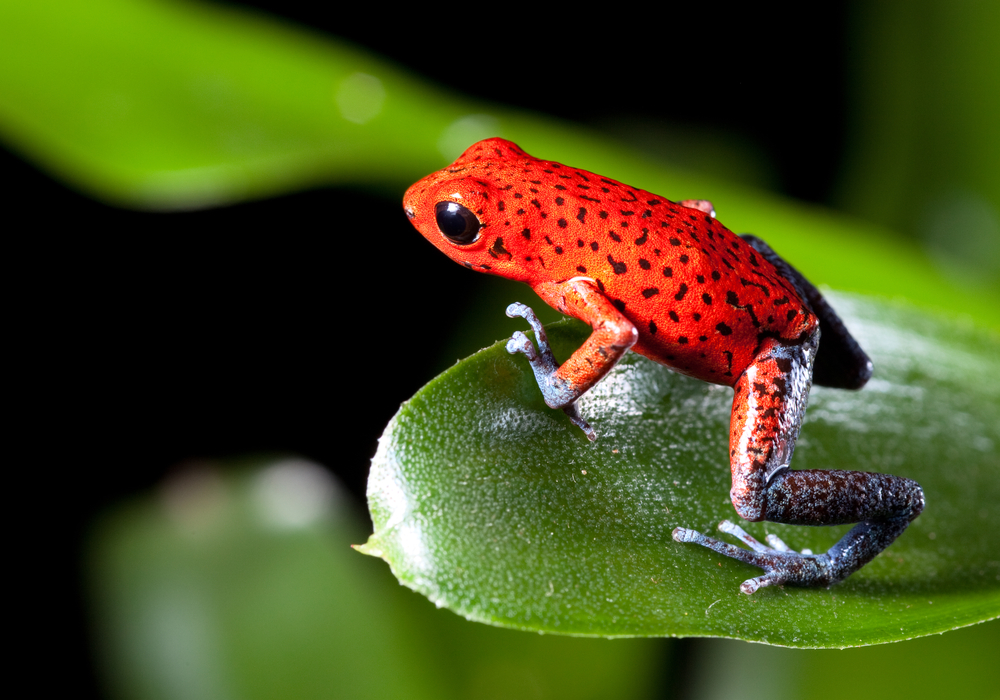
The poison dart frogs of Central and South America display some of the most stunning colors in the animal kingdom. Some types are cobalt or indigo; others are yellow, gold, strawberry pink or bright red with a stop sign and stripes on the back.
While these hues are lovely to admire, the color actually serves as a warning sign to potential predators: Eat me and I’ll poison you.
How these creatures and other animals evolved to be colorful enough to signal their toxic defenses — but not so colorful as to make them vulnerable to predators — has long been a gray area for scientists.
Now a new study published in the journal Science can explain the phenomenon.
“We know that evolution can explain the features we see, but studying the mechanics of how we get from one place to another really provides a deeper understanding of nature,” said Carl Loeffler-Henry, a researcher at Carleton University and one of the lead authors of this study.
A common survival tactic /colorful frogs
Being brilliantly colored to signal to predators that you’re toxic, deadly, or simply “not breakfast” is a phenomenon called aposematism.
It is widespread among luscious amphibians, reptiles, insects and other creatures.
This characteristic has also evolved independently in different lines of animals with chemical defenses. So it’s clearly a handy party trick in the annals of evolutionary survival.
But evolutionary scientists have long puzzled over how animals could have evolved to be so sparkly without succumbing to predators in the first place.
The Paradox of Vulnerable Prey / colorful animals
Evolution occurs when a random genetic mutation makes certain animals of a species more likely to survive and reproduce.
A variation such as this bright color pattern is thought to have posed a dilemma for the first individuals in which the mutation occurred.
This is because initially predators would not have known that the bright colors signaled toxicity and would therefore have eaten—and then gotten sick—those easily spotted members of a species with a color mutation.
In theory, this should make it virtually impossible for aposemic pioneers to pass their genes on to their offspring, allowing the mutation to become established in the population.
“You have this kind of paradoxical catch-22 where the prey has to be taken by the predator in order for the predators to be trained to associate the color with the toxic defense,” Loeffler-Henry says. “But when predators sample those individuals, it’s necessarily lethal to the individual.”
Read more: The bright colors of this poisonous frog strangely help to camouflage it
Data from 1100 flower species
To get to the bottom of this paradox, Loeffler-Henry’s team examined data from the family trees of 1,100 species of frogs, newts and salamanders and categorized them into one of five groups.
At one end of the spectrum are the creatures with fierce blues, yellows and reds that set them apart from the rest. This group, the notable group, includes icons such as various different colored frogs with poison darts.
At the other end of the spectrum: amphibians that blend in perfectly with their surroundings.
Painted in muted greens, browns and grays, they camouflage themselves in their habitats in a mysterious way. Think about Vietnamese mossy frog (Theloderma corticale), which looks like it’s actually covered in moss.
Between these poles, scientists place amphibian species with varying degrees of camouflage tops and colorful bottoms—some with bright bellies, some with colorful lower limbs, some with a bit of both. They tend to show their dramatic sideburns only when they are trying to protect themselves from predators.
The Hong Kong warty newt (Paramesotriton hongkongensis) belongs to this category because it is brown above and mottled orange below. So does the black and yellow toad (Melanophryniscus stelzneri), which is black on the back and spotted bright red on the belly.
Modeling the different possibilities
Loeffler-Henry’s team used nine different computer models to test the potential evolutionary paths that frogs, newts and salamanders in the conspicuously aposematic group might have taken to evolve this way.
Eventually, the researchers realized that they all followed a similar pattern.
Aposemic amphibians almost always evolve from species in the middle of this spectrum, those whose colors are veiled unless in danger.
“We found that the transition from camouflage to aposematism is rarely straightforward,” Loeffler-Henry says.
Rather, the phase of intermediate covert signals seems to have facilitated the transition in most cases.
Various environmental benefits
Of course, that doesn’t mean all species will evolve to be super toxic and super colorful.
Depending on the environment, there are unique advantages that come from being either a camouflaged species, or one that uses covert signals—or one that is completely bright and aposematic.
Many toxic amphibians also still camouflage, Loeffler-Henry points out.
Read more: 6 animals with unusual evolutionary traits
Alternative theories
There are other theories proposed to resolve this paradox of brightly colored amphibians.
One suggests that predators may initially be wary of attacking new prey.
Another suggests that predators can share with each other, through social learning, the knowledge that bright colors signal danger.
But this new theory presents a mechanism that is likely to play a role in the evolution of anti-predator defense across different prey groups and a wide range of different predators, says Alice Exnerova, a professor of zoology at Charles University in Prague, who was not involved in the new study.
Non-amphibian application
“This process is possible [of having hidden colors] may have played an important role in the evolution of warning coloration in animal groups other than amphibians,” says Exnerova.
For example, there are fish, moths, mantises and grasshoppers with hidden warning color patterns that place them in the middle of the noticeable camouflage spectrum.
To test how widespread this evolutionary trick is in the animal kingdom, more studies looking at animals like these could reveal a rainbow of results.
Read more: Can evolution explain all dark animal behaviors?

